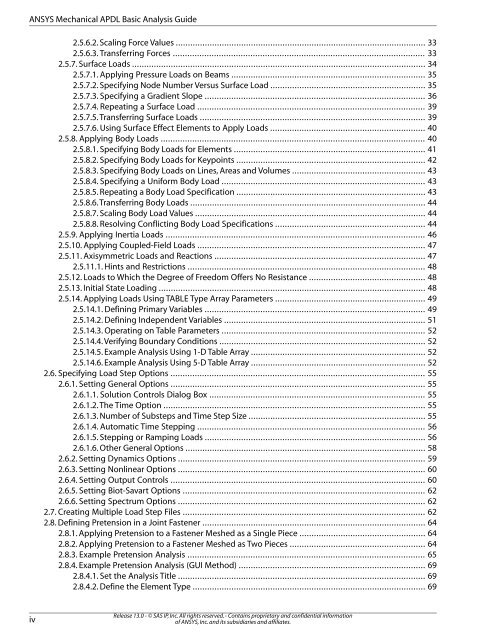Mechanical APDL Basic Analysis Guide - Ansys
Mechanical APDL Basic Analysis Guide - Ansys
Mechanical APDL Basic Analysis Guide - Ansys
Create successful ePaper yourself
Turn your PDF publications into a flip-book with our unique Google optimized e-Paper software.
ANSYS <strong>Mechanical</strong> <strong>APDL</strong> <strong>Basic</strong> <strong>Analysis</strong> <strong>Guide</strong><br />
iv<br />
2.5.6.2. Scaling Force Values ....................................................................................................... 33<br />
2.5.6.3. Transferring Forces ........................................................................................................ 33<br />
2.5.7. Surface Loads ......................................................................................................................... 34<br />
2.5.7.1. Applying Pressure Loads on Beams ................................................................................ 35<br />
2.5.7.2. Specifying Node Number Versus Surface Load ................................................................ 35<br />
2.5.7.3. Specifying a Gradient Slope ........................................................................................... 36<br />
2.5.7.4. Repeating a Surface Load .............................................................................................. 39<br />
2.5.7.5. Transferring Surface Loads ............................................................................................. 39<br />
2.5.7.6. Using Surface Effect Elements to Apply Loads ................................................................ 40<br />
2.5.8. Applying Body Loads ............................................................................................................. 40<br />
2.5.8.1. Specifying Body Loads for Elements ............................................................................... 41<br />
2.5.8.2. Specifying Body Loads for Keypoints .............................................................................. 42<br />
2.5.8.3. Specifying Body Loads on Lines, Areas and Volumes ....................................................... 43<br />
2.5.8.4. Specifying a Uniform Body Load .................................................................................... 43<br />
2.5.8.5. Repeating a Body Load Specification .............................................................................. 43<br />
2.5.8.6.Transferring Body Loads ................................................................................................. 44<br />
2.5.8.7. Scaling Body Load Values ............................................................................................... 44<br />
2.5.8.8. Resolving Conflicting Body Load Specifications .............................................................. 44<br />
2.5.9. Applying Inertia Loads ........................................................................................................... 46<br />
2.5.10. Applying Coupled-Field Loads .............................................................................................. 47<br />
2.5.11. Axisymmetric Loads and Reactions ....................................................................................... 47<br />
2.5.11.1. Hints and Restrictions .................................................................................................. 48<br />
2.5.12. Loads to Which the Degree of Freedom Offers No Resistance ................................................ 48<br />
2.5.13. Initial State Loading .............................................................................................................. 48<br />
2.5.14. Applying Loads Using TABLE Type Array Parameters .............................................................. 49<br />
2.5.14.1. Defining Primary Variables ........................................................................................... 49<br />
2.5.14.2. Defining Independent Variables ................................................................................... 51<br />
2.5.14.3. Operating on Table Parameters .................................................................................... 52<br />
2.5.14.4. Verifying Boundary Conditions ..................................................................................... 52<br />
2.5.14.5. Example <strong>Analysis</strong> Using 1-D Table Array ........................................................................ 52<br />
2.5.14.6. Example <strong>Analysis</strong> Using 5-D Table Array ........................................................................ 52<br />
2.6. Specifying Load Step Options ......................................................................................................... 55<br />
2.6.1. Setting General Options ......................................................................................................... 55<br />
2.6.1.1. Solution Controls Dialog Box ......................................................................................... 55<br />
2.6.1.2. The Time Option ............................................................................................................ 55<br />
2.6.1.3. Number of Substeps and Time Step Size ......................................................................... 55<br />
2.6.1.4. Automatic Time Stepping .............................................................................................. 56<br />
2.6.1.5. Stepping or Ramping Loads ........................................................................................... 56<br />
2.6.1.6. Other General Options ................................................................................................... 58<br />
2.6.2. Setting Dynamics Options ...................................................................................................... 59<br />
2.6.3. Setting Nonlinear Options ...................................................................................................... 60<br />
2.6.4. Setting Output Controls ......................................................................................................... 60<br />
2.6.5. Setting Biot-Savart Options .................................................................................................... 62<br />
2.6.6. Setting Spectrum Options ...................................................................................................... 62<br />
2.7. Creating Multiple Load Step Files .................................................................................................... 62<br />
2.8. Defining Pretension in a Joint Fastener ............................................................................................ 64<br />
2.8.1. Applying Pretension to a Fastener Meshed as a Single Piece .................................................... 64<br />
2.8.2. Applying Pretension to a Fastener Meshed as Two Pieces ........................................................ 64<br />
2.8.3. Example Pretension <strong>Analysis</strong> .................................................................................................. 65<br />
2.8.4. Example Pretension <strong>Analysis</strong> (GUI Method) ............................................................................. 69<br />
2.8.4.1. Set the <strong>Analysis</strong> Title ...................................................................................................... 69<br />
2.8.4.2. Define the Element Type ................................................................................................ 69<br />
Release 13.0 - © SAS IP, Inc. All rights reserved. - Contains proprietary and confidential information<br />
of ANSYS, Inc. and its subsidiaries and affiliates.

















